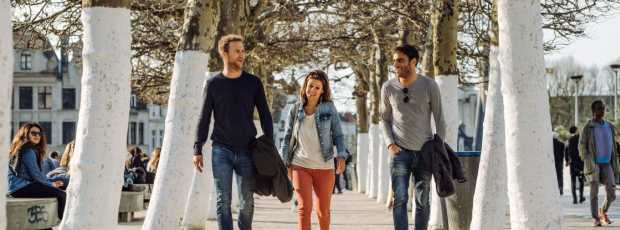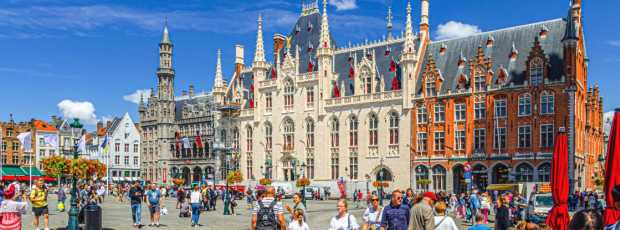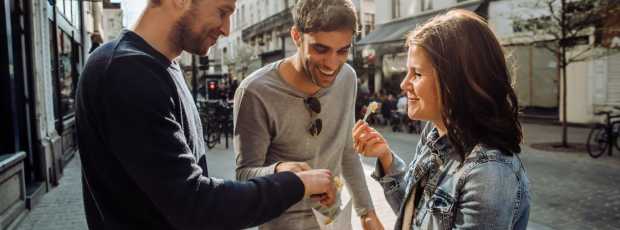Table Of Contents
- Escaping Tourist Brussels
- Offbeat Landmarks That Tell Real Stories
- Secret Art & Culture Beyond the Guidebooks
- Unexpected Green Spaces
- Alternative Brussels Eats and Drinks
- Lesser-Known History and Local Life
- Unique Experiences Off the Beaten Track
- Exploring Brussels' Neighborhoods Like a Local
- Museums and Cultural Experiences
- Practical Tips for Alternative Brussels Exploration
- Why Brussels' Alternative Side Matters
Escaping Tourist Brussels
Most visitors to Brussels make the predictable pilgrimage to Grand Place, snap photos of Manneken Pis, and call it a day. But this beautiful city offers far more interesting things to do in Brussels for those willing to venture beyond the beaten track. Non touristy things to do in Brussels do exist.
This guide reveals alternative things to do in Brussels that show you a side of the city most tourists never see. Instead of rushing between major attractions, take time to discover Brussels' hidden gems through neighborhoods, antique shops, and the comic strip route that weaves through the city's fabric.
Offbeat Landmarks That Tell Real Stories
Brussels' Comic Strip Trail
In Brussels, the art of the comic strip has taken to the streets. The comic strip route represents one of Brussels' most distinctive hidden gems, allowing visitors to learn about the architectural heritage of the city as well as the omnipresence of the comic strip in Brussels' culture.
This self-guided path is composed of several comic strip murals covering the walls of buildings throughout the inner city of Brussels, as well as the neighborhoods of Laeken and Auderghem. The 5km route features over 80 large comic strip murals that depict scenes from various popular Belgian comics, including The Adventures of Tintin, The Smurfs, Lucky Luke, Gaston, and Marsupilami.
The route begins near the city center and winds through neighborhoods most visitors never explore. Each mural tells a story about Belgian comic strip culture while also revealing the character of the communities where they're painted. Following the comic strip route is a free way to discover Brussels organically. Transforming the city into an open-air gallery where art integrates seamlessly into daily life.
Brussels' Three Peeing Statues
While everyone knows about Manneken Pis, Brussels actually has three peeing statues scattered throughout the city. This quirky trio; Manneken Pis, Jeanneke Pis, and Het Zinneke, offer a perfect excuse to explore different neighborhoods while uncovering one of the city's most amusing traditions.
Manneken Pis, the famous little guy near Grand Place, he often disappoints with his modest size. But his true charm lies in his extensive wardrobe and the local tradition of dressing him in different costumes. Jeanneke Pis hides in Impasse de la Fidélité near the Galeries Royales Saint Hubert. Het Zinneke stands on Rue des Chartreux, representing Brussels' multicultural spirit. Fun fact: The name "Zinneke" itself refers to a mixed-breed dog in the local dialect.
The three peeing statues represent something deeper about Brussels' character. In a city that takes itself seriously as the capital of Europe, these irreverent monuments remind everyone that Brussels maintains its sense of humor.
Hidden Places: Impasse de la Fidélité and Rue des Chartreux
Impasse de la Fidélité is a small, charming cul-de-sac located near the famous Rue des Bouchers. This narrow passage feels like stepping into a different era, maintaining an almost medieval atmosphere that serves as a reminder of how Brussels built itself around intimate courtyards and passages.
The impasse's most well-known feature is Jeanneke-Pis, the female counterpart to Brussels' iconic Manneken Pis statue. This small statue of a little girl urinating was unveiled in 1987, and legend has it that throwing a coin into its basin brings fidelity to lovers.
Historically, this passage was once known as "allée du dragon" (dragon alley).
In the 1930s, Impasse de la Fidélité was known for its gay and lesbian bars, becoming part of Brussels' LGBTQ+ history. More recently, in the 1960s, it housed more clandestine establishments when queer nightlife was less free. The street has also been the subject of artistic and literary works, including a book by Paul Gérard titled "Impasse de la Fidélité," which delves into family and collective history relating to gay public spaces in Brussels.
Rue des Chartreux is located in the western part of Brussels' historic center, running approximately 200 meters from Rue Van Artevelde to Place du Jardin aux Fleurs. The street showcases Brussels' multicultural character, combining old Brussels architecture with shops and cafés that reflect the city's diverse population.
Its name, "Rue des Chartreux" (Street of the Carthusians), derives from the Carthusian order of monks. A Carthusian convent was built in the 16th century, and the street was formed during its construction. While the Carthusian monastery and its urban refuge disappeared by the 19th century, the street retains its historical name, referencing their past presence in the area.
Secret Art & Culture Beyond the Guidebooks
Brussels' Street Art Scene
Brussels' street art extends far beyond the official comic strip route. The city's walls tell stories about immigration, social change, and artistic rebellion. The areas around Saint Catherine and the European Quarter contain some of Brussels' most compelling street art, often commenting on local issues from gentrification to European politics.
Finding the best street art requires abandoning structured itineraries and allowing yourself to wander. The most interesting pieces appear in unexpected places: underneath bridges, on abandoned buildings, or in neighborhoods undergoing transformation. This approach rewards curiosity over careful planning.
Antique Shops and Hidden Treasures
Brussels' antique shops offer one of the most rewarding ways to explore the city's history. The Marolles neighborhood, particularly around Place du Jeu de Balle, contains the highest concentration of vintage stores. Here, you'll find everything from Art Nouveau furniture to vintage comic books. The area, also known as the "old market," hosts a daily flea market with a wide variety of second-hand and vintage items. Here, you'll find everything from Art Nouveau furniture to vintage comic books.
Additionally, the surrounding streets like Rue Haute and Rue Blaes are also lined with antique shops, making it a prime destination for antique enthusiasts.
What makes Brussels' antiquities special is how they function as unofficial community centers. Step into any Marolles shop on a Thursday afternoon and you'll find the owner debating EU policy with a regular customer while simultaneously appraising someone's grandmother's silverware. These aren't sterile retail spaces but living rooms where neighborhood drama unfolds over dusty chandeliers and forgotten paintings.
Each purchase becomes a cultural exchange where you're not just buying an object, you're inheriting a piece of Brussels' social history.
Saint Catherine: Artisanal Vibes
Sainte-Catherine district in Brussels, is well-known for its vibrant atmosphere, rich history, and a strong presence of artisanal products, particularly food
Saint Catherine encapsulates the essence of a neighborhood that celebrates local production, traditional craftsmanship, and a focus on quality, whether it's in the fresh produce at its markets, the seafood served in its restaurants, or the unique items found in its independent shops. It's a place where you can experience an authentic and lively Brussels atmosphere.
When visiting Brussels, remember that Place Sainte-Catherine (Sainte-Catherine Square) is a central hub for various markets that embody artisanal spirit: Organic Market: Every Wednesday, Zero Waste Market: On Saturdays, and seasonal markets, including the popular Christmas Market.
Looking for a private city experience in Brussels?
Explore the city with a local who plans a private day just for you; no groups, no scripts.
Unexpected Green Spaces
Parc du Cinquantenaire: Hidden in Plain Sight
Parc du Cinquantenaire offers one of Brussels' most underappreciated experiences. While many visitors photograph the triumphal arch and move on, the park contains hidden corners that reveal different aspects of Brussels' character. The space commemorates Belgium's fiftieth anniversary of independence but functions as much more than a historical monument.
The park's museums attract specialized audiences rather than general tourists, meaning the space maintains a quieter, more contemplative atmosphere. The hidden gems include quiet corners where you can sit and observe Brussels life unfold, offering perspective on the city's rhythms.
Secret Spots in Green Spaces
Brussels contains numerous secret spots that offer respite from urban intensity. These hidden places range from small courtyards tucked between buildings to forgotten parks that locals use as private gardens. The city's complex geography creates natural hiding places that feel like personal discoveries.
Many of Brussels' secret spots exist because of the city's layered history. Medieval passages, abandoned industrial sites, and forgotten squares create opportunities for discovery. These spaces feel like genuine hidden gems rather than shared tourist experiences.
Alternative Brussels Eats and Drinks
Beers and Bars
Brussels' beer tradition represents one of the city's most distinctive culinary experiences. Unlike mass-produced Belgian beers found in tourist areas, fruit beers offer complexity that reflects centuries of brewing innovation. The best beers come from small breweries in neighborhoods away from main tourist circuits.
Local bars that specialize in Belgian beers often function as neighborhood gathering places where regulars discuss politics and local events. These establishments provide opportunities for cultural exchange that don't exist in more tourist-focused venues.
Hidden Cafés for Whipped Cream and Chocolate
Brussels has hidden cafés that offer experiences focused on serving locals rather than tourists. These establishments often specialize in specific treats, from perfectly prepared waffles to chocolate that reflects centuries of Belgian expertise. The best discoveries often happen in residential neighborhoods where rent costs allow businesses to focus on quality over quantity.
Lesser-Known History and Local Life
European Quarter's Hidden Corners
The European Quarter extends beyond the obvious institutional buildings to include neighborhoods where European Union employees tend to live. These areas offer insight into how Brussels has adapted to its role as Europe's capital while maintaining its Belgian character.
The contrast between the European Quarter's official face and residential reality creates fascinating juxtapositions. You'll find small Belgian restaurants next to international businesses, creating cultural mixtures that exist nowhere else in the world.
What if your day in Brussels was planned by someone who knows it — and you?
City Unscripted matches you with a local host who creates a private experience based on your interests, not a set route.
Unique Experiences Off the Beaten Track
Coudenberg Palace Ruins
The Coudenberg Palace ruins represent one of Brussels' most fascinating hidden gems. These underground remains of a former palace lie beneath Place Royale, offering visitors a chance to explore Brussels' buried history. The experience feels like archaeological discovery rather than typical museum visit.
The palace ruins reveal layers of Brussels' political history invisible from street level. Walking through these underground spaces, you encounter foundations where history was shaped during the Middle Ages. The underground location naturally limits crowds, making each visit feel like a private discovery.
Laeken Greenhouses
The Laeken Greenhouses offer one of Brussels' most exclusive experiences. These Royal Family greenhouses open to the public for only a few weeks each year, typically in spring. The limited access transforms the visit into a special event rather than routine tourism.
The iron and glass structures create cathedral-like spaces where tropical plants thrive in the Belgian climate. The combination of architectural beauty and botanical abundance creates an almost otherworldly experience enhanced by the royal connection and exclusivity.
Les Marolles Flea Market
Les Marolles flea market offers one of Brussels' most interesting shopping experiences. This treasure trove of vintage and second-hand items operates in a neighborhood that maintains its working-class character. The market provides opportunities to discover unique objects while observing Brussels community life.
The market's inventory reflects Brussels' diverse population and complex history. You'll find everything from African artifacts to Art Nouveau furniture. The vendors frequently know the stories behind their objects, making purchases into cultural exchanges.
Exploring Brussels' Neighborhoods Like a Local
Dansaert District
The Dansaert district represents Brussels' creative evolution. This trendy neighborhood combines fashion boutiques, design shops, and canal-side cafés in a compact area that feels both international and distinctly Belgian. The district's transformation from industrial zone to creative hub illustrates Brussels' adaptation to changing economic conditions.
The area's canal-side location provides unique perspectives on Brussels' geography. The waterways that once transported goods now serve as scenic corridors for walking and cycling, demonstrating how Brussels has adapted its infrastructure to support contemporary lifestyle preferences.
Marolles Neighborhood
The Marolles neighborhood maintains its working-class character while attracting artists and creative professionals. The neighborhood's cultural diversity creates opportunities for authentic cultural exchange between different immigrant communities and traditional Belgian establishments.
KBR (Royal Library of Belgium)
KBR, also known as the "Albertine," represents one of Brussels' most overlooked architectural gems. This impressive library building combines modern architecture with one of Europe's most significant collections of books and documents. The library offers opportunities to experience Brussels' intellectual culture while accessing resources that illuminate the city's history.
The building's contemporary design creates inspiring spaces that demonstrate how Brussels has successfully balanced historical preservation with modern functionality. The library serves as a working institution rather than tourist attraction.
Museums and Cultural Experiences
Museum of Medicine
The Museum of Medicine offers one of Brussels' most unusual cultural experiences. This quirky museum showcases medical history through displays that include wax figures depicting various diseases and medical conditions. The museum appeals to visitors interested in medical history and those who appreciate the unconventional.
The museum's approach avoids sanitized presentations in favor of authentic historical artifacts and realistic displays. This specialized focus creates an intense, immersive experience that feels uniquely educational rather than routine cultural obligation.
Villa Empain
Villa Empain represents one of Brussels' most stunning architectural achievements. This beautifully restored Art Deco villa showcases the intersection between artistic vision and wealth during the 1930s. The villa's rich and sometimes turbulent history reflects broader themes about Belgium's colonial past and artistic patronage.
Every architectural detail reflects Art Deco design at its most sophisticated. The restoration has preserved these elements while making them accessible to contemporary visitors. The villa's current use as a cultural center adds contemporary relevance to its historical significance.
Parliamentarium and House of European History
The Parliamentarium and House of European History offer insight into Brussels' role as Europe's capital. These interactive museums provide opportunities to understand European integration from historical and contemporary perspectives, making complex political processes accessible to general audiences.
The House of European History takes a broader approach, examining how European identity has evolved over centuries. The museum addresses difficult topics while exploring how Europeans have worked toward integration, providing context for understanding contemporary European challenges.
Tip
We match you with the right host, not just any guide.Want to experience the real Brussels with someone who lives there?
A fully private experience, planned and led by a local host who tailors the day to you
Practical Tips for Alternative Brussels Exploration
Navigation and Timing
Exploring Brussels' hidden gems requires different strategies than visiting major tourist attractions. Walking remains the most effective method for discovering alternative attractions, as the city's compact size makes most hidden gems accessible on foot. Public transport can connect different neighborhoods efficiently.
Many of Brussels' secret spots operate on different schedules than major attractions. The Laeken Greenhouses open only during specific periods, while some locations look different depending on lighting and weather conditions. Understanding these variables helps you plan visits that maximize your experiences.
Local Interaction
Respect for local communities becomes particularly important when exploring Brussels' hidden gems. Many of these places function as neighborhood spaces where residents live and work. Making an effort to use basic French or Flemish phrases often results in more authentic interactions and recommendations.
Language considerations can enhance your exploration significantly. While most Brussels residents speak multiple languages, linguistic courtesy opens doors to conversations that aren't available to obviously tourist-oriented visitors.
Why Brussels' Alternative Side Matters
Brussels' alternative attractions offer experiences that challenge common assumptions about the city. Rather than the boring bureaucratic capital many expect, these hidden gems reveal a creative, diverse, and historically complex city where different cultures have created something uniquely Belgian.
The value of exploring Brussels' beaten track lies not just in discovering new places but in understanding how contemporary cities can maintain local character while serving international functions. Brussels' success in balancing these roles offers lessons that extend beyond tourism.
For those seeking to explore Brussels through Brussels experiences that go beyond the typical tourist trail, the city offers countless opportunities for authentic discovery. These hidden gems Brussels provided reveal a city that's far more complex and interesting than its reputation suggests.
The best alternative things to do in Brussels require curiosity, patience, and willingness to engage with local communities. These experiences transform visitors into temporary residents, creating understanding that extends far beyond typical tourism. Brussels' alternative side offers rewards that last long after the visit ends.
Ready to plan your perfect day in Brussels?
Start your experienceWhat if your day in Brussels was planned by someone who knows it — and you?
City Unscripted matches you with a local host who creates a private experience based on your interests, not a set route.
Want to experience the real Brussels with someone who lives there?
A fully private experience, planned and led by a local host who tailors the day to you











